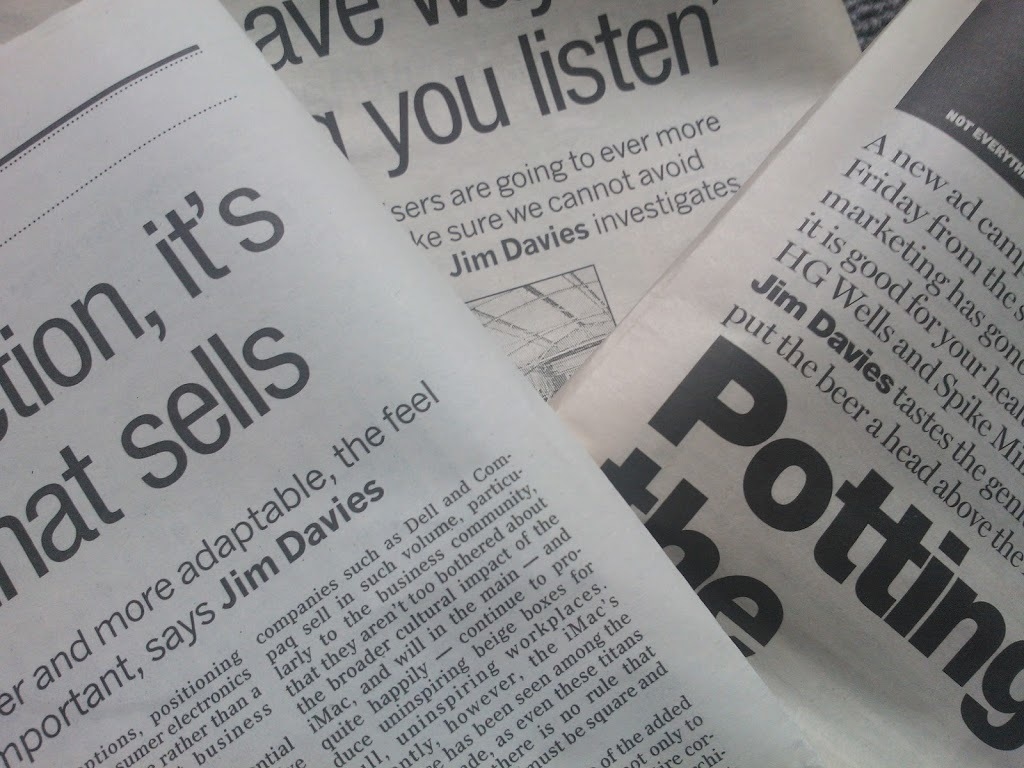whose line is it anyway?
A couple of years ago, I spoke at a D&AD copywriting event. During the Q&A session at the end, I was asked whether I felt threatened by a new generation of talent coming through. In a rare and rash moment of of bravado, I answered “no, of course not”. But having had a few months to chew it over, I think a more balanced (if less illuminating) answer would be “I don’t know”.
Above: Bye-bye to bylines... in commercial writing your words aren’t your own
The point is, in commercial writing the author is very rarely credited. I occasionally read copy that makes me smile or prompts a pang of envy. I read plenty that makes me cringe. But, unless I happen to know who’s ‘in’ with the client or design company involved, I have little idea who to pat on the back or poke in the eye.Indeed, I’ve seen pieces of word-heavy print where the designer, photographer, illustrator, printer, printing press and even paper are credited, but the person who wrote the whole darn thing is pointedly overlooked. It’s like hearing a cover version of a song on the radio… you’re given the artist and title as a matter of course, but rarely the songwriter’s name – without whom the ditty wouldn’t exist. Back in the days when I wrote for magazines and newspapers, I got used to getting bylines aplenty. Now it’s only occasionally at awards and in the ever-dwindling design press that I might get a grudging mention.I remember being quite pleased with my contribution to an annual report a few years back, and making a point of asking for a credit. I’d spent four days locked up in a windowless room as a succession of high-powered lawyers told me what kind of a year their department had had. It was demanding, complex stuff. And after weeks of hard toil at the keyboard, I felt I’d made them sound accomplished, personable and human.But the client came back with a resounding no, on the grounds that the words were meant to be those of the company, rather than a hired hand. I was free to feature the work on our website, but a credit on the document itself was out of the question. It’s a fair argument… writing for brands is about being a chameleon, almost invisible, yet finding the right voice and words to articulate someone else’s pronouncements. You’re only the messenger (and quite often the interpreter).But on the other hand, if the audience are comfortable with the fact that the client didn’t layout the report or shoot the photos themselves, why shouldn’t they accept that an expert was brought in to deliver the words too? There’s a certain kudos commissioning the latest hot-shot designer or even specifying double-recycled FSC paper. But for a client to admit that they had to get someone in to speak for them is somehow perceived a failure to adequately communicate.Some writers are inextricably linked with certain brands. John Webster with John Smiths and Cadbury’s Smash; David Abbott with The Economist and Sainsbury’s; David Hieatt with Howies and now Hiut Denim; Dan Germain with Innocent. But every brand is always bigger than the mouthpiece. It’s only when a catchphrase or moment of writerly brilliance passes into the vernacular that the man in the street might idly wonder who’s behind it.The flip side of this is that there are many pieces of work I’d much rather keep quiet about. Commercial copywriting is almost inevitably about compromise, accommodating different opinions, weaving in input from here there and everywhere, making a patchwork quilt look like a seamless duvet. Yes, I’ve had moments to be proud of, but many more that are probably best left anonymous.So to all you young whipper-snappers out there, good luck to you. I may not know who you are, but in all probability, you’re doing a grand old job.
